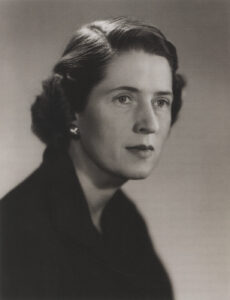Today’s post comes from Bella Dalton-Fenkl, class of 2020 and Art Center Student Docent.
I remember one day last term when I arrived at the Art Center and was met with a surprise—I had to give a tour to fifty people. Unsurprisingly, I felt panic. As I led them through the 20th century gallery, I turned to Henry Moore’s bronze sculpture Double Standing Figure. In my mind, I thought, “Lend me strength, Double Standing Figure,” and the sculpture seemed to give me a comforting look, despite its unmoving nature.

Bronze, Gift of Edgar Kaufmann, Jr., 1955.9.
This moment made me consider something I had always sort of believed, but had not thought about in-depth before: from moment to moment, works of art can appear to change personalities. In fact, once one has spent enough time with a piece of art, it can become like a friend. As a docent, and as someone who grew up in Poughkeepsie and has visited this museum for many years, I feel this quite strongly.
For example, Veiled Woman by Carrier-Belleuse often appears to be melancholy to me, but on any given day the woman seems more cold, resigned, or bittersweet, although the actual bust has not visibly changed. I have also grown attached to this work, as it is one of my favorites in the collection and have often included it in my tours. The work need not be naturalistic, either; William Baziotes’s painting, Night Mirror (which Isa, a fellow docent, has written about in another blog post) has brushwork, colors, and compositional elements I often perceive to be stressful—even nauseating—and yet on some days it makes me feel calm and contented. In fact, I am writing the draft of this post sitting in front of Night Mirror, in my favorite seat in the museum. Baziotes’s painting seems to be keeping me company, and its stressful quality does not make its “friendship” any less pleasant.

Purchase, Louise Woodruff Johnston, class of 1922, Fund, 1972.28.
Finally, these pieces do not even have to be representational of physical objects. Agnes Martin’s multimedia work, The Harvest (which appears to be a grid in graphite and paint) has no figures and no naturalistic elements. Yet I feel the same connection to the Martin that I experience with the others I have mentioned. The slight irregularities in the rectangles of the grid draw my eye into the picture, and I notice every small detail as I spend time with the work, as if I am looking at a scintillating dots optical illusion. This is what I generally feel when looking at The Harvest, yet on some days this sensation is meditative, and on others it is draining. I also feel that this piece is a friend; I know that when it was removed from display for a time, I felt as if someone I used to see every day had moved away.
Perhaps it is only what I bring to these works that causes such feelings. After all, is art art without a viewer to perceive it? However, I honestly do feel as if I have built a relationship with these works. I suppose that, on some level, that can be proven. Art “gives” the viewer a stimulus, and in return the viewer perceives the art and “gives” it an interpretation. Yet even beyond this, I feel a fondness for certain works that is difficult to describe. When I think to myself, “How are you doing today, Double Standing Figure?” I could swear it somehow sends me a smile back, despite having no “mouths” on its “faces” to speak of! So the next time you visit the museum, why not think “Hello” to the works and then see how you feel?




